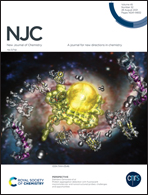Construction of novel polyethylenimine-g-C3N4/BiOCl heterojunctions for the efficient photocatalytic degradation of nitro explosives†
Abstract
Nitro explosive photocatalytic degradation is of great importance. Herein, novel and efficient polyethylenimine-g-C3N4/BiOCl (PEI-CN/BC) heterojunctions were constructed through electrostatic self-assembly. Zeta potential results showed that the PEI-CN surface was positively charged. Transmission electron microscopy findings proved that PEI-CN and BC successfully formed a close contact PEI-CN/BC heterostructure. The photocatalytic effect of PEI-CN/BC on PNP degradation was also investigated under simulated light conditions. The results showed that the obtained 1PEI-CN/2BC (mass ratio of PEI-CN to BC was 1 : 2) had the best photocatalytic effect and could completely degrade PNP in 90 min. The apparent rate constant (k) of the reaction was 21.9 and 4.0 times that of PEI-CN and BC alone, respectively. Photoelectrochemistry and photoluminescence results showed that the improved electron–hole separation was the main reason for the superior photocatalytic performance of PEI-CN/BC. Free radical trapping experiments and electron paramagnetic resonance measurements revealed that superoxide radicals were the major active substance in the photodegradation. This work provides inspiration and alternatives in designing new efficient 2D/2D heterogeneous photocatalysts for the efficient degradation of nitro explosive wastewater.



 Please wait while we load your content...
Please wait while we load your content...